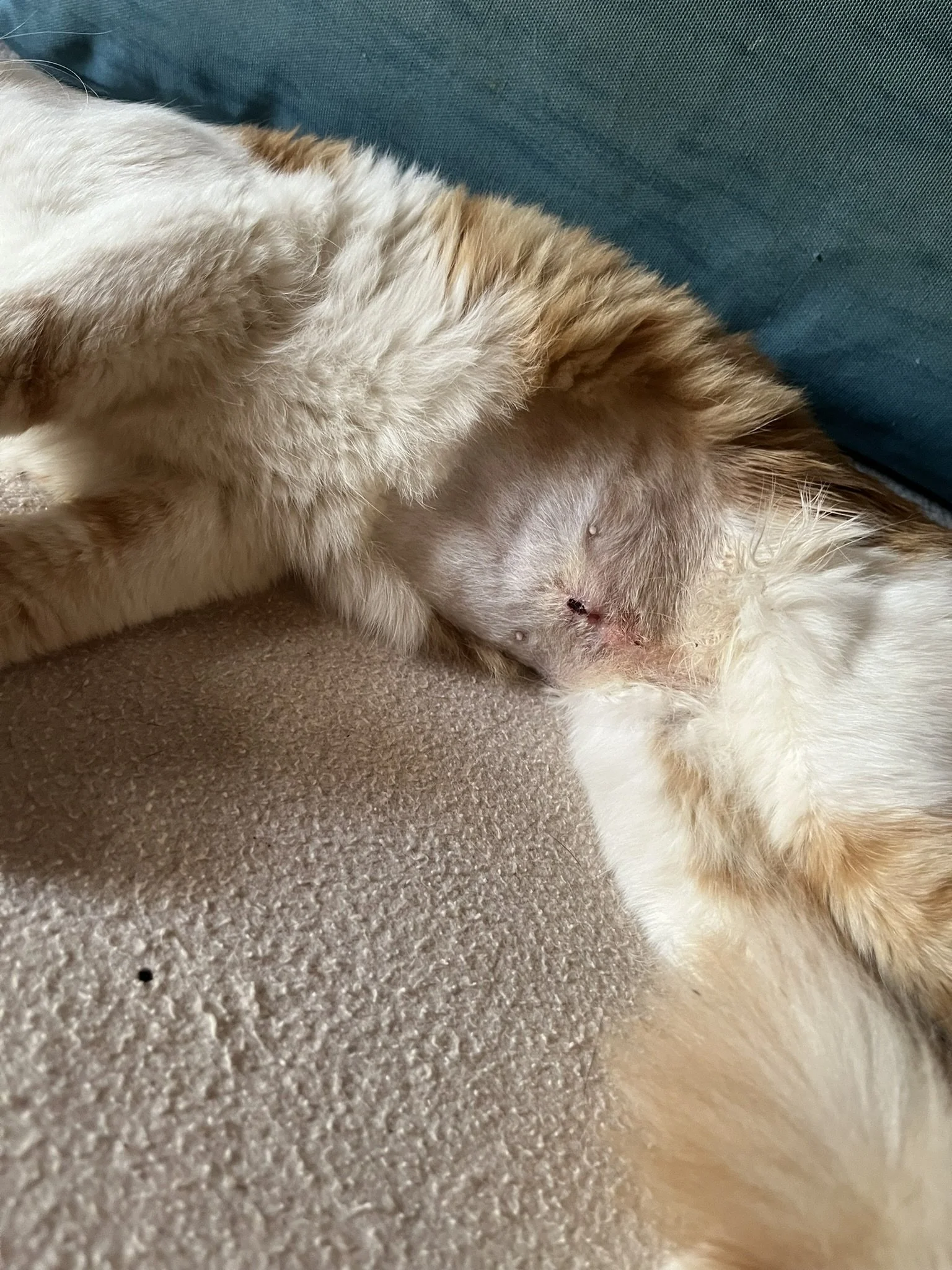Caring for cats with medical challenges
At our shelter, we are committed to helping cats and kittens who are facing various health challenges. From eye infections to viral diseases, our dedicated team works alongside our local vet to ensure every cat receives the care they need to heal and thrive. This page provides an overview of some of the most common medical issues we encounter, and how we address them.
Whether it's treating fungal infections, managing the symptoms of calicivirus, or providing antibiotic injections, we aim to give each cat the best possible chance at recovery. For wounds, we apply medicated creams to promote healing and prevent infection. Through our work, we ensure that every cat, no matter their condition, is given the love and medical attention they deserve.
Explore the sections below to learn more about these specific health issues and how we manage them at the shelter. Keep in mind that the following content may contain blood and (serious) wounds.
Eye infections are a common issue among street cats, particularly those living in harsh and unsanitary environments. These infections can be caused by bacteria, viruses, or even injuries, and if left untreated, they can lead to serious complications, including vision loss. At our shelter, we prioritize early detection and treatment to ensure the best outcomes for affected cats.
Our veterinary team carefully examines every cat that comes into our care, checking for signs of conjunctivitis, corneal ulcers, or other eye conditions. In addition to treating the eyes, we also clean their ears, as ear infections or mites can often accompany eye problems. We remove ear mites using specialized treatments, usually in the form of drops, and treat infected ears for two weeks to ensure complete recovery.
Treatment for eye infections often involves a combination of antibiotic drops or ointments, oral medications, and in severe cases, surgical intervention. Cats with infections receive daily attention and care to ensure their comfort and recovery.
Through timely treatment and ongoing monitoring, we aim to not only heal their eyes but also restore their quality of life.
Eye- & ear infections
One of the most common issues we encounter at the shelter is feline ringworm, a fungal infection that affects a cat’s skin, hair, and nails. It’s easy to spot: cats with ringworm often show circular patches of hair loss, dry or scaly skin, irritated areas, and sometimes, infected claws. The discomfort leads to excessive scratching and grooming, making the infection even worse if left untreated.
With the right treatment, ringworm can be completely cured. At our shelter, we treat affected cats with a specially formulated fungal spray, which we receive from a Dutch vet. This spray contains an active ingredient also found in fungal shampoo, and it works wonders! After just 1.5 to 2 weeks of regular treatment, many of our cats are already healed and free from the infection.
However, treating ringworm requires more than just medicine. Cats with this infection must be kept in strict quarantine to prevent it from spreading to others. This adds to our daily workload, as these cats need extra care and attention in isolation. Despite the challenges, we are committed to giving them the time and treatment they need to recover fully and return to the shelter’s healthy population.
Fungus virus
We often encounter cats that require wound healing due to various injuries. One memorable case was Gogo, a beautiful ginger cat brought to us by a couple living in Dahab. Gogo had been struck by a car or motorcycle, resulting in severe damage to the skin and structure of his back leg.
For three weeks, our dedicated medical team provided Gogo with meticulous wound cleaning and bandage changes every other day. This rigorous treatment regimen was essential for preventing infection and promoting healing. Thanks to the care and attention he received, Gogo made a remarkable recovery and was eventually adopted by a loving family. He now uses his leg perfectly, showcasing the resilience of cats when given the proper medical care.
Additionally, as many cats leave our shelter to make fun outside the walls, the chance of them returning with injuries from fights increases. We regularly see cats coming back with small or large wounds, requiring prompt treatment and cleaning. Our team is committed to providing the necessary care to ensure these cats heal properly, allowing them to return to their happy lives.
Wound healing
Before (stitches were broken)
After 1 week of daily fresh bandage
In our shelter, where many cats live close together, respiratory infections can spread quickly. Cats often show symptoms such as sneezing, runny noses, or drooling due to colds or viral infections. If untreated, these illnesses can worsen, so we act fast to provide the necessary care.
For most sick cats, we begin with antibiotic syrup to treat any bacterial infections that may be present. In more severe cases, we administer a course of antibiotic injections, which help to fight infections more quickly. All treatments are carefully handled by our medical manager, who ensures each cat receives the right medication and dosage.
To prevent the spread of illness, we quarantine sick cats during their 7- to 10-day treatment period, closely monitoring their recovery. Thanks to this approach, the majority of cats heal well and return to the main shelter, ready to interact with the others once again.
Long term sickness (viruses)
We frequently receive distressing reports about cats injured in accidents, such as being hit by cars or becoming trapped in hazardous situations. Among these stories are the inspiring journeys of four beautiful girls: Hope, Pie, Apple, and Minx. Each of them faced life-altering challenges due to their injuries.
Hope and Pie arrived at our shelter paralyzed in their back legs after a severe accident. Despite this setback, their spirit remained unbroken. Minx and Apple both lost a limb due to their injuries, but their determination to recover shone through. After undergoing surgery, they needed extensive care and rehabilitation to help them adjust to their new circumstances.
To support their healing, we provide comprehensive aftercare that includes pain management, physical therapy, and regular check-ups. We rely on the generosity of our sponsors to cover the costs of their surgeries and ongoing medical care. Each cat is given a quiet space away from the hustle and bustle of the shelter, allowing them to recover in peace and comfort. This calm environment is crucial for their physical and emotional well-being.
With time, patience, and dedicated support, these resilient cats learn to adapt and regain their mobility. Their journeys highlight not only their incredible strength but also the importance of compassion and care in helping animals overcome adversity.
Missing or damaged limbs
We often care for cats with missing or damaged eyes, and there are various reasons why a cat may end up with only one eye. Traumatic injuries from curious adventures can lead to scratches or punctures that result in eye loss. Infections and diseases, such as feline herpesvirus, can also cause severe eye problems, sometimes necessitating the removal of the affected eye. Additionally, some cats are born with congenital defects that impact the development of one eye.
Despite these challenges, visually disabled cats can lead fulfilling lives with the right care and support. It's essential to provide a safe and loving environment, allowing them to thrive despite their limitations.
Cats with missing or damaged eyes often experience discomfort, especially when eye discharge indicates an infection or injury. To ensure their well-being, we treat these cats daily with eye drops that hydrate and prevent dryness in their affected eyes or sockets. If we neglect this treatment, it can lead to severe inflammation, as seen with Ferdinand (first picture), whose non-existent eye socket was completely inflamed when he arrived at our shelter.
Missing or damaged eyes
We frequently receive messages from people who find newborn kittens, often with their eyes still closed, and mostly in strange places. While some of these kittens have been abandoned by their mothers, others may still have a chance of being reunited. However, due to the dangers on the streets of Dahab, many finders bring the kittens home for safety.
These well-meaning individuals often seek our help because feeding newborns every 2 to 3 hours is a demanding task, requiring around-the-clock care. Sadly, only about 15% of kittens survive without their mother on formula milk. They often lack the warmth and nutrition provided by their mother, making survival challenging. We use Royal Canin baby formula to give them the best chance possible, but even with this, many do not survive.
Despite the odds, we remain committed to giving these tiny lives a fighting chance, providing the care and support they need to thrive.






























